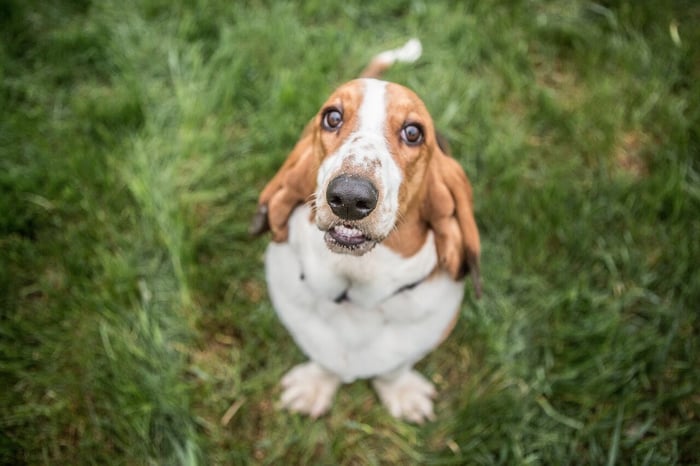Many pet owners wonder, can a dog see color or are they truly color blind? Contrary to popular belief, dogs can see colors, but their vision differs significantly from that of humans. While their ability to perceive colors is limited, dogs are not entirely colorblind. They have two types of color-sensing receptors, known as cones, in their eyes, which makes their color vision different from humans, who have three types. As a result, dogs are red-green colorblind, meaning they struggle to see these colors clearly. However, dogs can see colors such as blue and yellow quite well, which is why toys in these colors are often a better choice for your dog. In this blog, we will explore what colors dogs can see, how their vision compares to humans, and what this means for selecting toys and other items for your canine companion.
Understanding Dog Vision
Dogs ability to see the world is a subject that has captured interest lately. Contrary, to belief that dogs see in black and white hues studies reveal that they can perceive some colors although their range is narrower than ours. Recognizing how dogs see things is crucial, for owners, trainers and anyone looking to connect with their four legged friends.
"Dogs possess a form of vision called vision wherein they have two types of color receptors or cones, in their eyes. Sensitive to blue and yellow light. Enabling them to perceive those colors effectively but lacking the ability to detect red and green light; thus restricting their color perception significantly compared to humans and possibly affecting their response, to certain colors." By gaining insight into the way dogs perceive their surroundings and interact with their environment we can improve our decisions regarding toys, training equipment and other products that can enrich their day, to day experiences.
Dogs and Color Blindness: How Do Dogs See Colors?
Color blindness in dogs is similar to certain types of humans with color-blindness, specifically red-green color blindness. Dogs, like people with this condition, lack the cones that detect red and green. This results in dichromacy instead of trichromacy, where dogs see the world in two primary colors—blue and yellow. While humans have three types of cones (trichromatic vision), allowing us to see a broad spectrum of colors, dogs are missing one type of cone, which limits their ability to see varying shades of red and green.
The retina of a dog's eye contains more rods than cones. These rods are responsible for detecting movement and light in low-light conditions, giving dogs excellent night vision and making them adept at spotting moving objects. However, the trade-off is their limited ability to perceive certain colors.
What Colors Can Dogs See? Blue and Yellow Toys for Dogs
Dogs' color perception focuses primarily on two colors—blue and yellow. If you're wondering why your dog seems more attracted to certain toys, it's likely because they are easier for them to see. For instance, a blue ball is much more noticeable to a dog than a red toy, which might blend into the background. Therefore, when choosing toys for your dog, opt for blue and yellow rather than red and green, which they can't distinguish well.
Imagine your dog playing in a field of green grass. While the grass looks vibrant and green to you, your dog sees it in shades closer to gray. A yellow toy will stand out against this backdrop, making it easier for your dog to locate during playtime.
Why Can’t Dogs See Like Humans?
Dogs have evolved to be hunters – and with those super sensitive sight capabilities, they need a space that allows their eyes the freedom to roam. Dogs also need to keep their eyes glued to their targets rather than focusing on everything around them, making them look at their surroundings indirectly.
This quality makes it possible for dogs to have both excellent nighttime and daytime vision because it takes more than 20 times longer for a human eye to adjust from looking at something far away than it does for a dog. And as one might assume from the dynamics of any type of hunting, dogs also need good peripheral vision because that means they need to have a panoramic range of viewing without having to turn their heads all the way around or straining much at all.
Dogs are color blind, although this isn’t very important to them since they have adapted their eyes in a way that allows for the most effective use of their senses. Dogs rely more heavily on their sense of smell, which gives them a strategic advantage when it comes to early detection. That sharp ability to sniff out danger lets them survive in the wild and be able to navigate their way back home in a time of distress, like during a hunting trip.
Night Vision: Dogs See Better in Low Light
While dogs' color vision is not as rich as humans, they make up for it with their superior ability to see in dim light. Thanks to having more rods in their retinas, dogs are much better at seeing in low light situations than humans. Their larger pupils and reflective membrane, known as the tapetum lucidum, allow them to catch more light, improving their vision at night. This trait is especially beneficial for dogs that are used to hunting or navigating in the dark.
How Dogs' Vision Compares to Human Vision
Human vision differs significantly from canine vision. While humans have three cones that allow us to see a wide color spectrum, including reds, greens, blues, and yellows, dogs only have two types of cones. This limits them to seeing blue and yellow, which is why blue and yellow toys are ideal for dogs. Additionally, dogs rely more on their ability to detect small movements, thanks to the high number of rods in their eyes. This makes them excellent at spotting moving prey or objects in their peripheral vision, even if they cannot perceive colors as vibrantly as humans.
Understanding Dichromatic Vision: Why It Matters for Dogs
The vision of dogs is commonly characterized as dichromatic since they can only see two colors— yellow—which is akin, to the blue yellow color blindness found in humans causing trouble in distinguishing between blue and yellow shades due, to eye receptor irregularities Dogs manage well in their surroundings despite this form of color blindness as they depend on their sense of smell and hearing to make up for their restricted color vision abilities. Their knack, for spotting movement in lighting is also superior to that of humans which makes them adept hunters and companions for activities, during both daylight and nighttime hours.
How Do Dogs Perceive Color?
The retina is the main thing that creates the critical difference between the color perception of dogs and humans. The retina contains a part of it called the rods which are extremely sensitive cells that catch images in low light conditions. These contain Carotenoids, pigments helpful in responding to dimly-lit surroundings.
However, they are ineffective at identifying color under bright lights because they were not designed for such situations. Then there are Cones located inside the dark layer right below the rods. They work in bright illumination and help color perception by functioning just like our normal vision.
Dogs have over twice as many rods (which detect motion) in their retinas as people do so that dogs can see more moving objects simultaneously. People can only see a few of them. The human retina includes three kinds of cone cells that each senses a different color. Our trichromatic vision produces the same variety of colors our minds demand: reds, greens, and blues.
Dogs are dichromatic. They have only two types of cone cells; one for dark-to-light adaptation and one for bright-to-dark. Only the dark to light senses color differences equally well in both eyes, so two images may be merged into a single blurry image by the brain.
Each color cone registers a different wavelength of light. The cones that humans use to see red and green help us appreciate the nuances in objects, such as something like a beautiful rose or the crackling peel. Dogs, who are color deficient, can sometimes only see black and white (as much as we love them, their visual world is not as colorful), but their remaining cones allow them to detect some shades of blue and yellow.
What Does This Mean To You And Your Dog?
Now that you know dogs can't necessarily see the same colors we do because of the cones inside their eyes, it figures color choice will be a real factor in dog product selection. It's likely not surprising that dogs behave differently toward yellow tennis balls compared to other colors.
It’s a known fact among dog owners (and anyone else who works with animals) that you should never use red as your dog’s fetch ball. When using something red, your dog will likely lose sight of it in the high grass or water. It also might be overlooked if you're training them to differentiate between two objects by using one red and one blue toy.
Unfortunately, many pet toys mimic these colors to make them bright and eye-catching to humans. Still, your dog can have trouble deciphering them amongst green grass or any other surrounding foliage that they may be in. This can be pretty frustrating as an owner who can’t understand why their beloved canine friend doesn’t show interest in a new toy or treat.
When selecting a product for your dog blanket, always select blue and yellow. If you're looking for an excellent blanket for your dog, one type that you should consider is leaf-shaped blankets. They are always a good choice. These blankets come in different varieties and have the softest touch. You can either let your pup lie on top of this blanket or tuck them in if they want to play around, but they will always be happy either way! One of the great things about these offerings is that they come in beautiful colors and are easy for your dog to identify.
Select this thick and squishy square bread bed if you want to have some dog beds. It looks like a big piece of bread that perfectly fits into your home decor. The foam bit at the bottom gives it that lovely soft feel, and the color blends in easily very well. This is going to be the ideal bed for your little ones!
Choosing the Right Colors for Dog Toys and Products
When selecting products for your dog, it’s important to remember that their vision is optimized for blue and yellow hues. Dogs may struggle to distinguish between different shades of blue, specifically light blue and dark blue. Many dog owners make the mistake of choosing red or green toys, which are hard for dogs to differentiate from their surroundings, especially on green grass or in low-light conditions. If you’re training your dog to identify objects, stick to blue or yellow toys that are easily visible to them.
For example, when you throw a blue ball in the park, your dog will have no problem spotting it, while a red ball might disappear into the landscape. Understanding your dog’s vision can also help when choosing bedding, blankets, or other products—opt for items in shades of blue or yellow that your dog can easily see and recognize.
Age-Related Vision Issues in Dogs
As dogs age, their vision can deteriorate, leading to age-related vision issues. Just like humans, dogs can develop age-related macular degeneration, cataracts, and other eye problems that can affect their vision. Most dogs develop age-related vision issues between 9-11 years old, although some breeds may be more prone to vision problems than others.
For instance, cataracts can cause the lens of a dog’s eye to become cloudy, leading to blurred vision and, in severe cases, blindness. Age-related macular degeneration affects the retina, causing a gradual loss of vision. Regular veterinary check-ups can help detect these issues early, and there are treatments available that can help manage these conditions and improve your dog’s quality of life. By being aware of these potential problems, you can take proactive steps to ensure your aging dog remains happy and healthy.
Conclusion: What Colors Can Dogs See?
In summary, while dogs cannot see the world in the same vibrant colors that humans do, their color vision allows them to see certain shades of blue and yellow. This means that when choosing toys, blankets, or beds for your dog, it's best to go with these colors to ensure they can easily identify and interact with the items. Understanding your dog's vision not only helps you choose better products for them but also deepens your bond by allowing you to see the world from their perspective.
Read More:
https://funnyfuzzy.com/blogs/pet-encyclopedia/what-causes-swollen-eyes-in-dogs-and-how-to-help
https://funnyfuzzy.com/blogs/pet-encyclopedia/why-do-dogs-like-to-lick-ears











